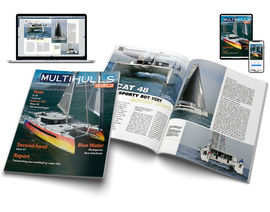Helia 44 for sell, ready to sail...
- Location :
- Le Marin, Martinique
- Year :
- 2015
Until recently reserved for long-term cruisers, Venezuela’s islands are exceptional, both for their beauty and their isolation. A treasure which you can now go and discover aboard one of the few catamarans available for charter in catamaran...
A real Polynesian lagoon, lost in the middle of the Caribbean, the Los Roques archipelago is a gem! A superb coral seabed, impressive underwater fauna and countless white sand beaches await you in this archipelago, situated in the extreme north of South America... Los Roques are 75 miles from the South American continent and Venezuela, on which they depend. With around fifty small and large islands and incredibly rich flora and fauna, the Los Roques archipelago has been a National Park since 1972. It is therefore very well protected: just one island is inhabited (Gran Roque), and very few tourists have access to it. It is therefore definitely a paradise for lovers of deserted anchorages, playing at Robinson Crusoe, and above all, exceptional cruising in catamaran. With temperatures ranging from 26 to 28°C, the destination is pleasant all the year round.
But Los Roques is not the only destination Venezuela offers. With more than 3000 kilometres of coast and no less than 311 small and large islands of an incomparable beauty; you could sail here in catamaran for years without getting bored...
And also...
Los Roques is just a 30-minute flight from Caracas. Once you have arrived in Gran Roque, you embark aboard your catamaran, and all that remains is to enjoy this coral gem, which forms the biggest marine sanctuary in the world. And if you stay for more than two weeks, there is nothing to stop you from going as far as Las Aves, for an unforgettable cruise.
Another solution: leave from Puerto La Cruz, which is a real centre for yachting in Venezuela. No fewer than six marinas await you there, with all the essential services, from which you can cruise towards La Tortuga, La Blanquilla, Margarita, Mochina National Park and Los Testigos...
A National Park since 1972, Los Roques is a group of around fifty islands and more than 200 small islands and sandbanks, situated 75 miles from the mainland. In other words, if you can’t find your little personal paradise here, you’re a hopeless case... There is a huge number of white sand beaches, and the waters are perfectly protected by a huge coral reef, where superbly protected flora and fauna abound. Some of our readers claim that the clearness of the water here is unequalled anywhere else on the planet. In any case, the seabed is sublime, and well worth exploring.
The archipelago is protected by two coral reefs, one of which stretches over 15 miles from north to south, and protects the islands from the current coming from the east, which explains the calm waters in Los Roques. The diversity of the scenery, with atolls, lagoons, mangrove swamps and deserted beaches, should appeal to even the most blasé cruisers.
On approaching La Blanquilla, you will be surprised by the white line outlined in the middle of the deep blue water. This is of course where the island’s name comes from; it is bordered by a band of white sand, 15 miles long. Here you will find transparent waters and wonderful coral, but as the water here is cooler than in Los Roques, the underwater life is completely different. With a bit of luck, you will be able to see dolphins, manta rays and even small whales and little sharks here. Above all, not to be missed!
Made up of seven small islands and a multitude of ‘cayes’, Los Testigos is a paradise for divers, both with tanks and with fins, mask and snorkel. But you will also find here some very beautiful white sand beaches, and above all, you will really feel the exuberance of the lush tropical vegetation. Bird lovers will also be delighted to discover an incredible colony here...
And if we had to choose just one? For many lovers of the Venezuelan islands, the Aves get the vote. Situated between Los Roques and Bonaire, this is actually two groups of islands: Aves de Barlovento and Aves de Sotavento. They are separated by a stretch of sea up to 1000 metres deep! The structure of the two groups is identical, formed by two arches, open to the west and made up of numerous tiny coral islands, bordering a shallow central lagoon. To the east of these two formations, we find an incredibly rich coral reef (that of Sotavento, stretching over 9 miles)...
Snorkelling, diving (on numerous wrecks) and dream anchorages are on the programme, especially as there is no other way to come to the Aves than by boat...
Between the incredible underwater drop-offs which border the south of the island (less than 600 metres from the island, the depth is already 380 metres) and the banks of white sand in the shallow translucent waters in the north, there is something for all tastes on La Tortuga. And as if that was not enough, you will see lots of turtles in the east, in a small lagoon surrounded by a singularly beautiful mangrove swamp.
Nicknamed ‘the Pearl of the Caribbean’, Isla de Margarita is superb, but bordered by hotels, and its ‘free port’ aspect attracts a lot of tourists. To be visited before going to look further afield...

What readers think
Post a comment
No comments to show.